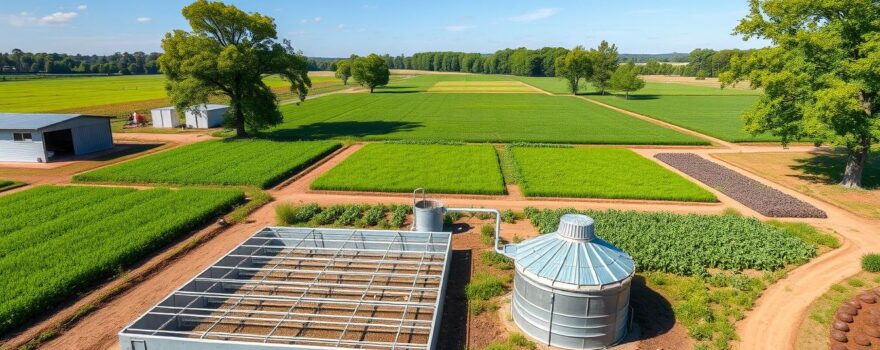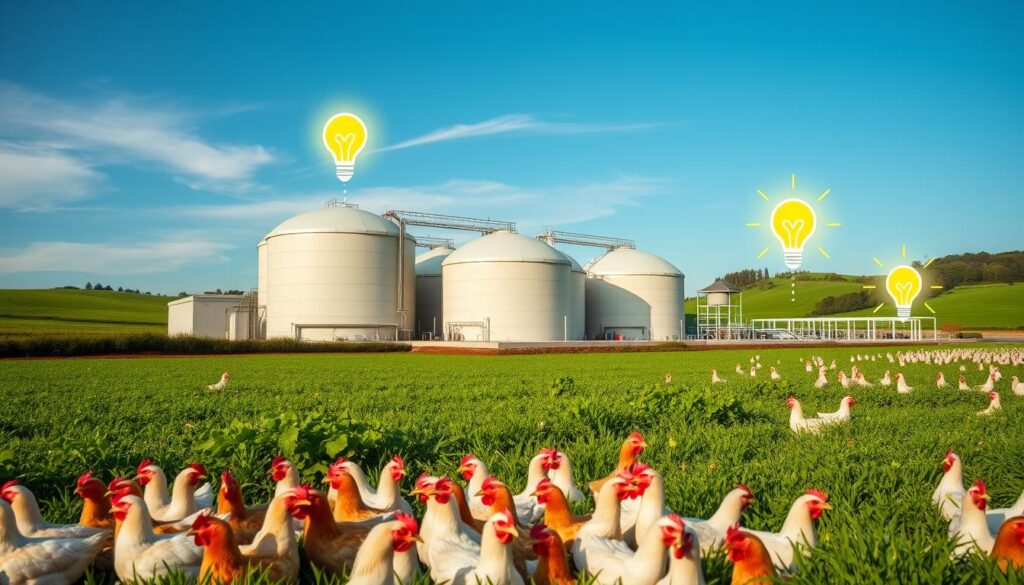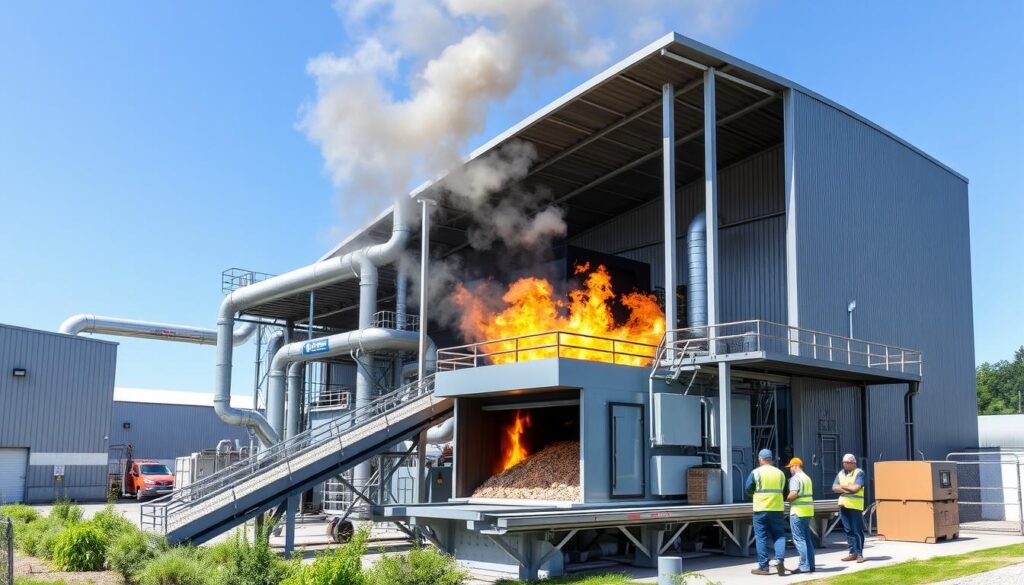
The poultry industry is a big player in meat production, with broiler chickens leading the way. But, the huge amounts of waste they produce are a big environmental problem. If not handled right, this waste can pollute soil and water, cause bad smells, and harm health.
To tackle the environmental issues of raising broiler chickens, we need a detailed plan. This plan should cover storing and containing waste, using it for land, composting, and more. By doing this, farmers can lessen the environmental harm and even turn waste into something useful. This helps make the industry more sustainable.
Key Takeaways
- Proper management of broiler chicken waste is crucial to mitigate environmental pollution and public health risks.
- Sustainable waste management strategies, such as composting, anaerobic digestion, and value-added product development, can transform poultry waste into valuable resources.
- Implementing effective storage, containment, and land application methods can help recycle nutrients and enhance soil fertility.
- Innovative technologies, like biochar production and advanced fertilizer formulations, offer new avenues for poultry waste utilization.
- Comprehensive poultry waste management plans are essential for promoting environmentally responsible and economically viable broiler chicken production.
Understanding Poultry Waste and Its Challenges
Poultry waste includes many things from farms, like poultry manure. It’s a mix of droppings, feathers, and spilled feed. There’s also poultry litter, which is the bedding in chicken houses. Then there’s hatchery waste, like eggshells and dead embryos. And lastly, there’s carcass waste, which are the bodies of dead chickens or other poultry.
Types of Poultry Waste
- Poultry Manure: A mix of droppings, feathers, and spilled feed, poultry manure is a big part of poultry waste.
- Poultry Litter: The soiled bedding in chicken houses, like wood shavings or straw, becomes poultry litter.
- Hatchery Waste: Products of the hatchery process, including eggshells, infertile eggs, and dead embryos.
- Carcass Waste: Dead bodies of chickens or other poultry that need to be disposed of properly.
Environmental Impact of Poultry Waste
Poultry waste can be a big problem if not handled right. It can harm the environment, cause bad smells, and pose health risks. It can pollute soil and water with too many nutrients and heavy metals, causing issues like harmful algal blooms. It also releases bad smells and gases like ammonia and methane, which can hurt the air and contribute to climate change.
Poultry waste can carry harmful germs like bacteria and viruses. These can spread to people or animals through water or direct contact, leading to sickness and disease.
Importance of Litter and Waste Management
Managing litter and waste is key in broiler chicken farming. It keeps birds healthy, reduces environmental harm, boosts farm efficiency, and follows the law. Good litter helps birds eat better and perform well. Also, managing waste well cuts down pollution, stops diseases, and keeps the farm healthy.
Broilers use a lot of water, most of which ends up as manure in the litter. This litter is full of nutrients that can be used as fertilizer. But, bad litter management can cause diseases, harm the environment, and lower farm efficiency.
Keeping the litter just right is crucial. Litter moisture should be between 20 to. Too much moisture can hurt birds and make the air toxic for workers.
“Ammonia concentrations of 50 to 110 ppm can cause the human eye to burn and tear and pose health risks to farm workers. EPA has set human exposure standards for ammonia at 25 ppm per 8 hours or 35 ppm per 15 minutes of exposure.”
Good litter management also stops diseases like avian flu and roundworms. Keeping the litter right helps keep birds healthy and safe from diseases.
Effective litter and waste management is also good for the environment and following the law. Properly handling poultry litter can cut down on pollution and greenhouse gases. It makes sure the farm meets local and federal rules.
In conclusion, managing litter and waste is very important in broiler chicken farming. By using the best methods and staying updated, farmers can make their farms better, keep birds healthy, protect the environment, and be sustainable for a long time.
Proper Storage and Containment Strategies
Good poultry farming means managing litter and waste well. Chicken farmers must focus on storing and containing litter properly. This helps reduce harm to the environment.
Poultry litter should go into leak-proof pits or lagoons. These should hold all waste until it’s cleaned out. Covering these areas keeps odors down and stops rain from polluting nearby water, preventing rainwater contamination.
- Almost all poultry production systems in South Carolina produce dry manure by-products, with few systems producing wet manure that requires lagoon treatment.
- Broilers, roasters, pullets, breeders, and turkeys are typically raised in litter-based systems, resulting in a dry solid manure or “litter” by-product with a sawdust or wood shavings base.
- Producers may clean out litter after every flock or after several flocks, with some going without a complete cleanout for one or more years.
Good storage and containment are key to controlling odors and minimizing environmental impact. Chicken farmers can follow best practices. This ensures their poultry litter storage and containment strategies work well. They can control odors and prevent rainwater contamination.
“Prevention is generally less costly than clean-up in managing broiler chicken waste spills.”
Having emergency plans and working with nearby farms helps manage manure emergencies. Being proactive helps chicken farmers minimize environmental impact. It also keeps their communities’ trust.
Land Application and Nutrient Recycling
Using poultry litter as fertilizer can recycle valuable nutrients. But, applying too much on the same land can harm the soil. It’s key to spread chicken litter on different fields. Nutrient management plans help manage these nutrients. They use soil testing, plant tissue testing, and calibrate manure-spreading equipment to avoid overloading the soil.
Nutrient Management Planning
Good nutrient management plans can cut down on farming costs. They prevent pollution too. These plans use soil and plant tests to ensure the right amount of nutrients are applied.
Soil Fertility Enhancement with Poultry Litter
Poultry litter can boost soil fertility and cut down on chemical fertilizers. When composted right, it’s a great natural fertilizer. It gives crops the nutrients they need to grow well. The best time to use it is when it’s first removed from the chicken house.
| Litter Type | Nitrogen (lb/ton) | Phosphorous (lb/ton) | Potassium (lb/ton) |
|---|---|---|---|
| Fresh | 60 | 55 | 40 |
| Stored | 40 | 55 | 35 |
| Composted | 30 | 50 | 30 |
Table 1 shows the average nutrients in broiler litters. Fresh, stored, and composted litter have different values. Keeping litter in covered areas helps keep its nutrient value high.
“Poultry litter has a calculated value of $25 to $50 per ton as a replacement for commercial fertilizers.”
Composting: A Sustainable Solution
Composting turns poultry waste into a valuable soil amendment. It uses microorganisms to break down organic matter. This process reduces environmental harm and makes the soil more fertile.
To compost well, you need the right mix of materials. Add carbon-rich items like sawdust or straw to poultry waste. Also, keep the compost moist and aerated. Regularly turning the compost ensures everything breaks down evenly.
| Composting Best Practices | Benefits |
|---|---|
|
|
The compost you make is a treasure for your farm. It’s a nutrient-rich soil amendment that boosts soil health. It also helps with water retention and cuts down on synthetic fertilizers. Composting is a green way to handle poultry waste.
“Composting is not just a way to manage waste, it’s a sustainable solution that can enhance the health and productivity of our land.”
Anaerobic Digestion for Energy Generation
Anaerobic digestion turns poultry waste into a valuable renewable energy source. This process happens in a special, oxygen-free environment. Here, microorganisms break down the organic matter in the manure, creating biogas.
This biogas is a gas mixture rich in methane. It can be used as a sustainable energy alternative. This helps reduce our reliance on fossil fuels.
Biogas Production from Poultry Waste
The U.S. poultry industry is a big source of methane emissions from manure. But, anaerobic digestion systems can cut these emissions by about 66,800 MT CO2e each year. These systems already process manure from about 2 million birds across the country, making electricity.
New projects aim to turn this biogas into renewable natural gas (RNG). This will make the biogas even more useful.
Utilization of Digestate as Fertilizer
The leftover digestate from anaerobic digestion is rich in nutrients. It can be treated and used as a nutrient-rich soil amendment. This digestate as fertilizer is a green alternative to chemical fertilizers.
Using digestate as fertilizer helps reduce our dependence on chemicals. It also supports a more circular economy for managing poultry waste. The nutrient-rich soil amendment from digestate can make soil more fertile and help plants grow better.
| Statistic | Value |
|---|---|
| Poultry manure in the United States as third-largest source of methane from livestock manure management | – |
| Reduction in CO2e emissions annually from AD systems processing poultry manure | 66,800 MT |
| Current AD systems processing manure from birds across the U.S. | 2 million |
| Methane yield from chicken manure (range) | 200–360 mL/g volatile solids |
| Biogas production from 1 kg of organic matter in chicken manure | ~0.5 m³ |

“Anaerobic digestion is a remarkable process that transforms poultry waste into a valuable renewable energy source.”
Environmental Control: Strategies for Managing Broiler Chicken Waste
Effective environmental control strategies are key for managing broiler chicken waste. Good poultry waste disposal helps farmers, communities, and the environment. A mix of methods works best for farms of all sizes.
Proper Storage and Containment
First, poultry waste needs proper storage and containment. Farmers should keep waste in sealed containers or pits. This stops waste from leaking into water sources.
Land Application and Nutrient Recycling
Using poultry litter on land is a green way to reuse nutrients. Nutrient management planning is vital. It ensures the right amount is applied to avoid harming the environment.
Composting: A Sustainable Solution
Composting is a smart way to handle broiler chicken waste. It turns waste into a soil enhancer. This method reduces waste and kills harmful bacteria.
Anaerobic Digestion for Energy Generation
Anaerobic digestion turns waste into biogas, a clean energy. The leftover can be fertilizer, making this method even greener.
Using these environmental control strategies helps farmers manage waste well. It makes poultry farming more sustainable. These methods also create useful products like energy and soil enhancers.
Incineration for Waste Reduction and Biosecurity
Incineration is a smart way to handle poultry waste, especially for dead birds and materials that can’t be composted. It burns chicken waste at high temperatures, cutting down the waste volume. This reduces the need for storage and lowers environmental risks from overflowing manure pits.
Incineration also boosts biosecurity on poultry farms. It burns waste that could harm the flock’s health or the environment. This keeps the farm clean and safe, preventing diseases from spreading.
Modern incineration technology makes waste management better for the poultry industry. Electricity production facilities estimated from poultry litter utilization rates of 1000 tons/year, 10,000 tons/year, and 50,000 tons/year for various technologies range from 34–70 kW, 340–700 kW, and 1.7–3.5 MW, respectively. It shows incineration can reduce waste and create energy, making poultry operations more sustainable.
“Incineration is particularly beneficial for disposing of waste that might be contaminated with disease agents, ensuring biosecurity on poultry and chicken farms.”
As the poultry industry grows, using incineration for waste management is key. It helps control the environment, keeps farms safe, and supports the industry’s long-term success.

Value-Added Products from Poultry Waste
The poultry industry can turn waste into useful products. This includes fertilizers, energy, and more. New methods are making waste into valuable resources.
Litter Ash and Fertilizer Production
Poultry litter is a mix of bedding and bird waste. It’s full of nutrients. After processing, it becomes litter ash, rich in phosphorus.
This ash is then made into high-quality fertilizers. It’s a green way to use poultry waste.
Rendering and Animal Feed Ingredients
Poultry waste, like mortalities and hatchery waste, can be rendered. This process cooks and processes the waste. It extracts proteins, fats, and oils.
These products are added to animal feed. It’s a smart way to use poultry waste.
| Value-Added Product | Composition | Applications |
|---|---|---|
| Litter Ash | High in Phosphorus | Fertilizer Production |
| Poultry Meal | Protein-rich | Animal Feed Ingredients |
| Poultry Fats and Oils | Lipid-rich | Animal Feed, Biofuels, Industrial Applications |
Turning poultry waste into valuable products helps the environment. It also brings in extra money. These new ways show how to manage waste in a green and smart way.
Innovative Approaches and Emerging Technologies
The poultry industry is always looking for innovative approaches and emerging technologies to make broiler chicken waste management better. They invest in automated manure collection and litter management systems. They also use sensors and IoT technologies to keep an eye on litter conditions. Plus, they adopt sustainable practices like rotational grazing and agroforestry.
They also use renewable energy solutions like biogas plants. This way, they can turn poultry waste into energy. This helps make farming more sustainable.
Recent studies show the benefits of these new methods. For example, Precision Livestock Farming (PLF) systems can make farming more profitable. Farmers like using data instead of old ways of managing.
Studies also found that housing conditions matter more than how crowded the place is. But, new tech like the Kai-Zen Feeding Robot and the eYeNamic system can help. They make sure feed is given right and spot problems quickly.
As the poultry industry grows, using these innovative approaches and emerging technologies will be key. They will make waste management better and more efficient. This will help the industry stay strong and take care of the environment.
“Digital innovation in agriculture has the potential to reduce poverty, hunger, and the consequences of climate change according to the United Nations Food and Agriculture Organization.”
Effective litter and waste management is key for a successful broiler chicken farm. By using the best practices and materials, farmers can improve production and keep birds healthy. This also helps reduce environmental harm.
The poultry farming industry has grown a lot, thanks to new technologies. These advancements help in genetics, nutrition, and disease control. Good litter management is vital for bird health and better production.
As more people want chicken products, farmers must manage waste better. Using composting or creating value-added products can help. This approach not only protects the environment but also brings in more money. With a focus on new ideas and flexibility, the poultry industry can have a bright future.